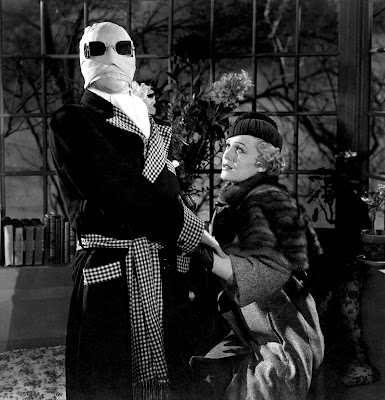The Invisible Man (1933)
Starring: Claude Rains, William Harrigan, Una O'Connor, Gloria Stuart, Forrester Harvey and Henry Travers
Director: James Whale
Rating: Eight of Ten Stars
Chemist Frank Griffin (Rains) develops a formula that turned him invisible. He goes on a homicidal rampage in rural Britain after it also drives him insane.
"The Invisible Man" is another true classic from the formative years of the horror genre. It's quite possibly the first horror comedy and it's black humor holds up nicely even today--arrogant scientists, simple country bumpkins and incompetent cops never go out of style!
The film's special effects also hold up surprisingly well, with simple techniques employed here that were used over and over until CGI came fully into its own but rarely used as well as they were here. (Yes, there are a few places where one can see the matting, but the "invisible action" here is depicted better than it is in many films made with much more sophisticated special effects technology.)
And finally, the film has a literate, finely honed script with loads of tension that effectively translates the mood of H.G. Wells' original novel to the screen. The characters seem well-rounded and believable, and this, even more than the special effects, make the movie such a pleasure to watch even now. The film even manages to capture the point about loss of identity resulting in loss of connection with the world around you and ultimately insanity (even if the movie attributes Griffin's madness first and foremost to the chemical concoction he's created).
Lovers of classy horror and sci-fi films owe it to themselves to check this one out. The same is true if you have an appreciation for dark comedies.
The Invisible Man Returns (1940)
Starring: Vincent Price, Cedric Hardwicke, Nan Grey, Cecil Kellaway, John Sutton and Alan Napier
Director: Joe May
Rating: Seven of Ten Stars
A wrongly convicted man (Price) uses an invisibility serum to escape execution and find the murderer who framed him. But, even with the help of his loving fiance (Grey) and his loyal best friend (Sutton), can he track the killer before he is driven mad by the substance that renders him invisible?
"The Return of the Invisible Man" is a well-conceived sequel. It's got significant ties to the original, retains some of the same basic themes, but presents a completely different and unique story. Too often, sequels either shoehorn connections to the film into the story in an artificial manner or have so little to do with the original that one wonders why a connection was even drawn (well, aside from naked greedy attempts to ride on the coat-tails of another film's success).
A well-scripted mystery is added to the invisible man shenanigans... and although it's a bit slow in getting started, it is a gripping tale once it gets going. The mystery isn't terribly hard to solve for those who like playing along--there really is only one suspect and the film never launches any serious attempt to divert the audience's attention from that villain. However, plenty of suspense arises from watching the invisible man start to lose his mind even as he identifies his prey.
The great cast of the film is also to be credited with its success. Most noteworthy among the actors are Vincent Price lends his distinctive voice to the film's unseen protagonist, and Cecil Kellaway who appears in a rare dramatic role as the inscrutable Inspector Sampson of Scotland Yard.
The only complaint I have with the film are the invisibility effects. Whether due to a lack of budget or creativity on the part of the director and special effects crew, there is nothing here as impressive as the cinematic tricks used to sell the presence of an invisible character on screen as was found in the original "Invisible Man" nor in the "Invisible Woman", a comedy dating from the same year yet featuring far more impressive effects. (Nothing in "The Invisible Man Returns" comes close to the bicycle stunt in "The Invisible Man" or the stockings scene in "The Invisible Woman".)
However, the solid story and excellent cast make up for the shortcomings in the special effects department.













.jpg)












.jpg)
